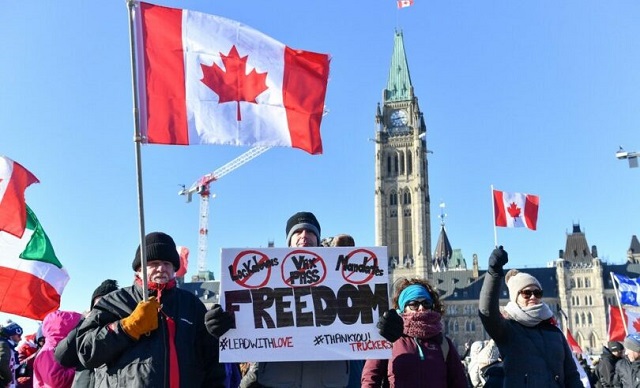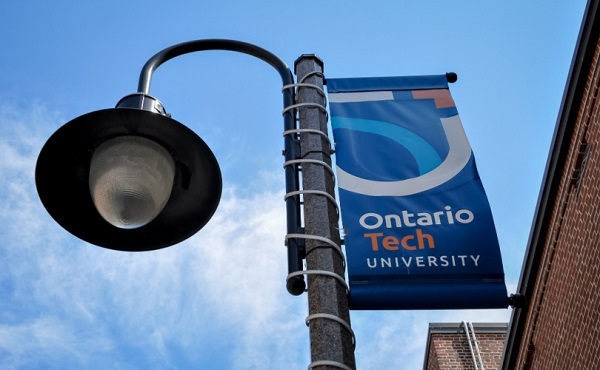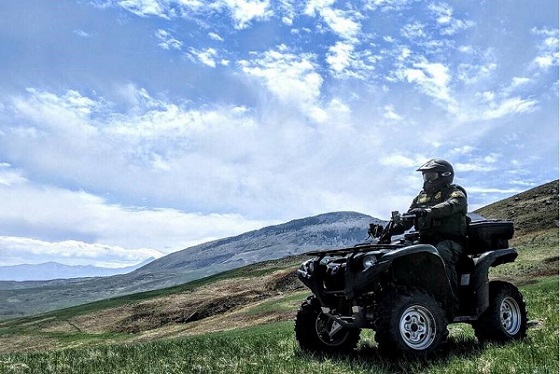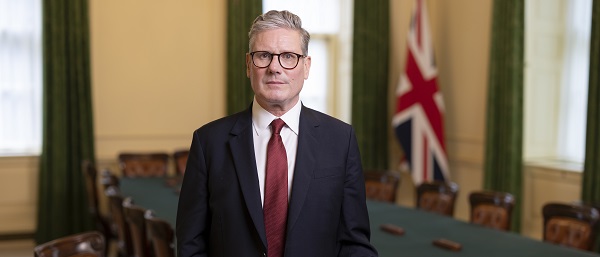COVID-19
Judge puts Freedom Convoy trial on hold until summer

From LifeSiteNews
Justice Heather Perkins-McVey is giving both sides more time to build a case.
The judge overseeing the trial for Freedom Convoy leaders Tamara Lich and Chris Barber adjourned the court proceedings until August to allow for the government to prepare legal arguments to back its claim that the leaders were “co-conspirators” as well as give time to the defense to prepare their case that the leaders are innocent.
The months-long court case started on September 5, 2023, in an Ottawa courthouse.
On Day 38 last Friday, the Democracy Fund (TDF), which is crowdfunding Lich’s legal costs, noted in a legal update that Justice Heather Perkins-McVey stated that she would not hear the “Carter application before closing arguments” but that “it will be heard simultaneously.”
The government has been hoping to use what is called a “Carter application” to help them make their case against Lich and Barber by trying to prove that the leaders were “co-conspirators,” meaning that accusations placed against one leader automatically apply to the other.
The government’s “Carter Application” asks that the judge consider “Barber’s statements and actions to establish the guilt of Lich, and vice versa.”
A Carter application requires that the government prove “beyond a reasonable doubt” that there was a “conspiracy or plan in place and that Lich was a party to it based on direct evidence,” and, as such, the defense is asking the judge to dismiss the application.
According to the TDF, Perkins-McVey delayed the trial until August so the government and the defense have time to “prepare their submissions without knowing the exact evidence admitted by the Court against each defendant.”
“This is because the Court’s ruling on the Carter application determines whether the statements of one defendant can be attributed to the other,” the TDF said.
Thus far, the government has asserted “that the absence of violence or peaceful nature of the protest didn’t make it lawful, emphasizing that the onus was on the Crown to prove the protest’s unlawfulness.”
The government has held steadfast to the notion in trying to prove that Lich and Barber somehow influenced the protesters’ actions through their words as part of a co-conspiracy. This claim has been rejected by the defense as weak.
The reality is that Lich and Barber collaborated with police on many occasions so that the protests were within the law. Lawrence Greenspon, Lich’s counsel, and Barber’s attorney, Diane Magas, have said they will argue against the Carter application.
The trial will resume August 13, with extra court dates planned for August 14-15 and August 19-23. LifeSiteNews has covered the trial extensively since it began last year.
Court will allow some ‘extra’ statements from Barber to be submitted
The court also ruled Friday that only some extra statements of Barber will be allowed to be admitted as per the “one statement rule.” Perkins-McVey will soon issue a ruling “shortly,” the TDF reported.
Day 37 included some “important” updates, according to their legal team, as their lawyers argued that allowing video to be entered as evidence would provide “context and completeness” into why they led the protests.
Last Thursday’s court proceedings saw Magas continue her “submission on the admissibility of statements of videos made by her client (Barber).”
Day 37 also saw the defense move to argue that the “Carter application should be ‘bifurcated’ — that is, it should be heard and ruled upon by the Court before closing submissions.”
On Day 36, lawyers argued that video statements made by the leaders should be allowed as “evidence of the truth.”
The trial resumed for one day, on March 7, for only the second court date since the new year, with Perkins-McVey deciding to dismiss an application by the Freedom Convoy leaders that asked the court to throw out so-called conspiracy charges.
Lich and Barber are facing multiple charges from the 2022 protests, including mischief, counseling mischief, counseling intimidation and obstructing police for taking part in and organizing the anti-mandate Freedom Convoy. As reported by LifeSiteNews at the time, despite the non-violent nature of the protest and the charges, Lich was jailed for weeks before she was granted bail.
Besides the ongoing trial, Lich and Barber and a host of others recently filed a $2 million lawsuit against the Trudeau government for its use of the Emergencies Act (EA) to quash the Freedom Convoy in 2022.
In early 2022, thousands of Canadians from coast to coast came to Ottawa to demand an end to COVID mandates in all forms. Despite the peaceful nature of the protest, Prime Minister Justin Trudeau’s government enacted the Emergencies Act on February 14. Trudeau revoked the EA on February 23.
The EA controversially allowed the government to freeze the bank accounts of protesters, conscript tow truck drivers, and arrest people for participating in assemblies the government deemed illegal.
During the clear-out of protesters after the EA was put in place, an elderly lady was trampled by a police horse and one conservative female reporter was beaten by police and shot with a tear gas canister.
COVID-19
Canadian Health Department funds study to determine effects of COVID lockdowns on children

From LifeSiteNews
The commissioned study will assess the impact on kids’ mental well-being of COVID lockdowns and ‘remote’ school classes that banned outdoor play and in-person learning.
Canada’s Department of Health has commissioned research to study the impact of outdoor play on kids’ mental well-being in light of COVID lockdowns and “remote” school classes that, for a time, banned outdoor play and in-person learning throughout most of the nation.
In a notice to consultants titled “Systematic Literature Reviews And Meta Analyses Supporting Two Projects On Children’s Health And Covid-19,” the Department of Health admitted that “Exposure to green space has been consistently associated with protective effects on children’s physical and mental health.”
A final report, which is due in 2026, will provide “Health Canada with a comprehensive assessment of current evidence, identify key knowledge gaps and inform surveillance and policy planning for future pandemics and other public health emergencies.”
Bruce Squires, president of McMaster Children’s Hospital of Hamilton, Ontario, noted in 2022 that “Canada’s children and youth have borne the brunt” of COVID lockdowns.
From about March 2020 to mid-2022, most of Canada was under various COVID-19 mandates and lockdowns, including mask mandates, at the local, provincial, and federal levels. Schools were shut down, parks were closed, and most kids’ sports were cancelled.
Mandatory facemask polices were common in Canada and all over the world for years during the COVID crisis despite over 170 studies showing they were not effective in stopping the spread of COVID and were, in fact, harmful, especially to children.
In October 2021, then-Prime Minister Justin Trudeau announced unprecedented COVID-19 jab mandates for all federal workers and those in the transportation sector, saying the un-jabbed would no longer be able to travel by air, boat, or train, both domestically and internationally.
As reported by LifeSiteNews, a new report released by the Justice Centre for Constitutional Freedoms (JCCF) raised alarm bells over the “harms caused” by COVID-19 lockdowns and injections imposed by various levels of government as well as a rise in unexplained deaths and bloated COVID-19 death statistics.
Indeed, a recent study showed that COVID masking policies left children less able to differentiate people’s emotions behind facial expressions.
COVID vaccine mandates and lockdowns, which came from provincial governments with the support of the federal government, split Canadian society.
COVID-19
Ontario student appeals ruling that dismissed religious objection to abortion-tainted COVID shot

From LifeSiteNews
An Ontario Tech University student is seeking judicial review after the Human Rights Tribunal of Ontario ruled his beliefs did not qualify as protected ‘creed.’
An Ontario university student who was punished for refusing the COVID shot is contesting a tribunal ruling that rejected his religious objection to the vaccine.
In a November 28 press release, the Justice Centre for Constitutional Freedoms (JCCF) announced that a judicial review has been filed on behalf of former Ontario Tech University student Philip Anisimov after his religious objection to the COVID vaccine was dismissed by an Ontario court.
“Mr. Anisimov’s objection to the Covid vaccine was deeply rooted in his religious commitment to live according to biblical precepts,” Constitutional lawyer Hatim Kheir declared. “He hopes the Divisional Court will clarify that his religious objection was protected by the Human Rights Code and entitled to protection.”
In 2021, Ontario mandated that all students in the province show proof of vaccination unless they had an exemption or agreed to attend a COVID jab education session boasting about the shots. The third option was not available at Ontario Tech University, as schools could choose whether or not they would offer such a program to students.
Anisimov had requested an exemption from the experimental, abortion-tainted COVID shots on religious grounds but was denied and deregistered from his courses.
He was then forced to spend an entire extra year to complete his studies. According to his lawyers, Ontario Tech University’s decision to not approve his COVID jab exemption request “not only disrupted his career plans but also violated his right to be free from discrimination on the basis of religion, as protected by the Ontario Human Rights Code.”
The university’s refusal to honor his exemption prompted Anisimov to take legal action in April with help of the JCCF. However, the Human Rights Tribunal of Ontario rejected his religious objection, arguing that it was not protected as a “creed” under the Ontario Human Rights Code.
Now, Anisimov is appealing the ruling, hoping that his case will serve as a precedent for justice for students who were discriminated against for refusing the abortion-tainted vaccine.
“My hope is that this case helps set an important precedent and encourages Canadians to reflect on the direction our society is taking,” he explained. “My trust is that God does all things for the good of those who love Him, who are called by His purposes.”
COVID vaccine mandates, as well as lockdowns that came from provincial governments with the support of the federal government, split Canadian society. The mRNA shots have been linked to a multitude of negative and often severe side effects in children.
Beyond health concerns, many Canadians, especially Catholics, opposed the vaccines on moral grounds because of their link to fetal cell lines derived from the tissue of aborted babies.
-

 Energy2 days ago
Energy2 days agoA look inside the ‘floatel’ housing B.C.’s LNG workforce
-

 National2 days ago
National2 days agoAlberta will use provincial laws to stop Canadian gov’t from trying to confiscate legal firearms
-

 Energy2 days ago
Energy2 days agoELZABETH MAY HAS IT WRONG: An Alberta to Prince Rupert Oil Pipeline Will Contribute to Greater Global Oil Tanker Safety
-

 illegal immigration1 day ago
illegal immigration1 day agoWhile Trump has southern border secure, hundreds of thousands of illegal immigrants still flooding in from Canada
-

 Censorship Industrial Complex1 day ago
Censorship Industrial Complex1 day agoCanadian bishops condemn Liberal ‘hate speech’ proposal that could criminalize quoting Scripture
-

 COVID-192 days ago
COVID-192 days agoCanadian legislator introduces bill to establish ‘Freedom Convoy Recognition Day’ as a holiday
-

 Business2 days ago
Business2 days agoUS Energy Secretary says price of energy determined by politicians and policies
-

 Censorship Industrial Complex1 day ago
Censorship Industrial Complex1 day agoForeign Leaders Caught Orchestrating Campaign To Censor American Right-Wing Media Companies



